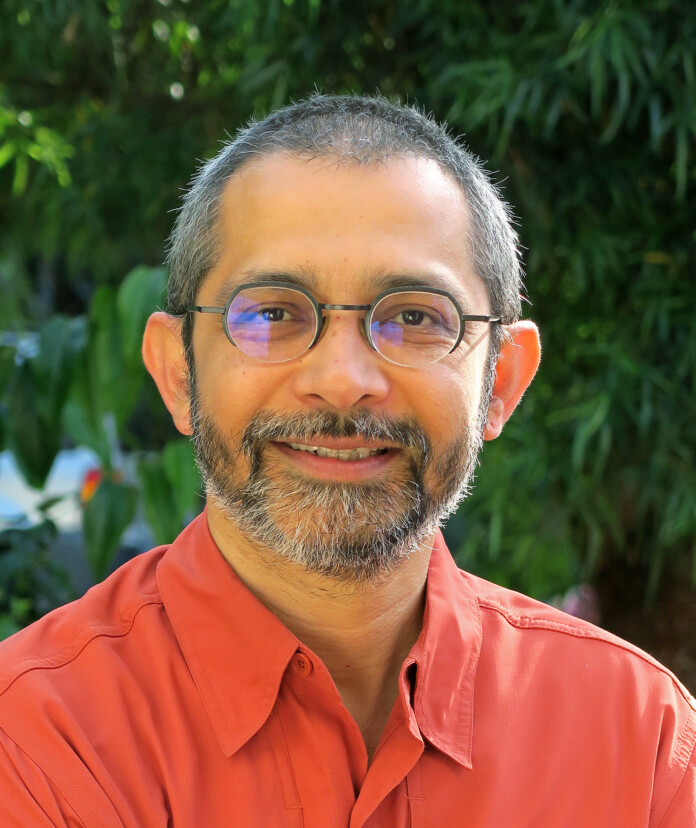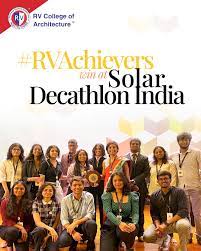Solar Decathlon India has shown that with the right access to cutting-edge curriculum, students are able to design net-zero buildings within a year.
A 15-student team from VNIT Nagpur recently designed a smart police station at Punapur for the Nagpur Smart and Sustainable City Corporation. Their objective was to transform the police station from being an intimidating place to one that is people-friendly.
The team reduced water consumption by 43% and achieved a net-zero water performance by using harvested rainwater and treated greywater. They prioritized thermal comfort and capped maximum indoor temperatures at 32º Celsius. They achieved this with an exterior bamboo skin and shading devices to reduce cooling loads and supplemented that with passive downdraft evaporative cooling and stack effect ventilation in courtyards.
Team Green Collars led by R V College of Architecture, Bengaluru, worked with Ekagra, to design a Delhi Public School for Gyandeep Foundation, that included a research and design lab focusing on sustainability and hands-on learning. They conducted seismic simulations to test their design of an RCC and bamboo framed structure with expansion joints and achieved resilience to low-impact high-frequency earthquakes. Their comprehensive multi-hazard risk assessment led to a design that provided up to 4 days of autonomy with critical functions in case the building was cut off from utilities and services, and they detailed a response and recovery plan for disaster events.
The two student teams were a part of Solar Decathlon India (SDI), a platform that gets students, educational institutions, real-estate developers and the building industry to collaborate on net-zero energy-water and waste solutions. The nine-month long challenge enables students to come up with sustainable building solutions for real proejcts.
SDI complements the existing curriculum with training modules, webinars, and technology support. It encourages students to work in teams so that they get better with soft skills for collaboration, management, and communication.
Solar Decathlon India is conducted by the Indian Institute for Human Settlements (IIHS) and the Alliance for an Energy-Efficient Economy (AEEE) under the aegis of the Indo-US Science and Technology Forum (IUSSTF).
Impact
In the last three years, student teams have collectively worked on 45 million square feet of new buildings. Their solutions have shown how 20 million tonnes of carbon emissions could be avoided.
SDI has created an ecosystem of 3,800 industry-ready students from 150 architecture and engineering colleges, with 200 faculty members, hundreds of real estate developers and building industry experts, who are all enthusiastic about working on resilient and net-zero buildings.
Leading real estate developers, including Mahindra Lifespaces, Sobha, TATA Realty, Lodha, Sumadhura, and Infosys have joined the cohort of partners providing live projects and internships to SDI participants.
India must accelerate strategies to implement net-zero approaches and disaster-resilient infrastructure. Architects, engineers and other building industry professionals will play a crucial role in this. There is an urgent need for an educational curriculum that imparts skills and creates future-ready next-gen leaders.
They must have cutting-edge skills and hands-on experience for working on these problems so that they can hit the ground running when they enter the building industry. They must be capable of making disaster resilient buildings that are net-zero, with decarbonised building materials, and climate-friendly technologies.
Integrating net-zero principles into the curricula of architecture and engineering programmes can offer significant benefits for students, enabling them to acquire advanced skills and knowledge of sustainable design practices. As in SDI, students need to get an opportunity to gain practical knowledge about real-world challenges and the know-how to design climate-resilient and sustainable buildings and associated materials and technologies.
These students who participate in SDI develop a deep understanding of sustainable building techniques and technologies, renewable and efficient energy systems, and innovative design strategies that use low-energy or passive energy solutions. They gain invaluable insights into the complexities of sustainable design, including cost-effectiveness in their approaches. They learn energy modelling, lifecycle analysis, and the integration of renewable energy systems. As a result, they develop a holistic perspective on sustainable buildings and acquire the expertise to tackle climate change.
New Engineering Approaches
Solar Decathlon India is paving the way towards a more sustainable and future-ready building industry. With the onset of its fourth year, the program has now initiated a new division – residential cooling retrofit as a product development challenge. This move is initiated from the recognition of the fact that existing buildings are much harder to transform but just as relevant for climate adaptation and mitigation.
The challenge in the new division is to reduce heat stress with passive cooling or improve cooling energy performance with technologies and innovative solutions that could be purchased off-the-shelf and installed in existing residences by homeowners themselves or with the help of local technicians.
The new product division invites new engineering approaches to cooling, bringing retrofit cooling solutions to the market. This new division brings in a new perspective for the students and the educational curriculum by bringing attention to our existing buildings and the innovations required to make them more efficient and healthier. It has already drawn the attention of the building industry.
SDI has become a movement towards a climate-resilient future and a just transition for all. It has created a ripple effect by using an exciting competition format to provide academic knowledge and engaging the industry as collaborators and mentors. Already 35% of the participating colleges have integrated SDI into their coursework. The Council of Architecture has enthusiastically endorsed SDI and invited colleges around the country to participate.
SDI has shown that within a year, students are able to learn and produce net-zero building designs. This is good news for government agencies who want to introduce stringent building codes for net-zero buildings. If students can do it, surely the industry can match their expertise or even surpass it.












